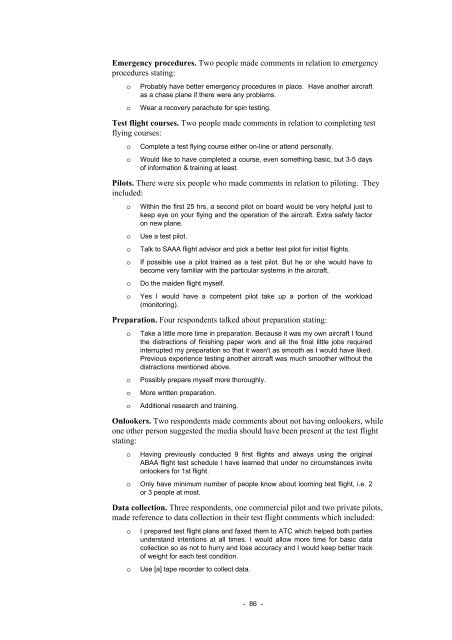Amateur-built and experimental aircraft - Australian Transport Safety ...
Amateur-built and experimental aircraft - Australian Transport Safety ...
Amateur-built and experimental aircraft - Australian Transport Safety ...
You also want an ePaper? Increase the reach of your titles
YUMPU automatically turns print PDFs into web optimized ePapers that Google loves.
Emergency procedures. Two people made comments in relation to emergency<br />
procedures stating:<br />
o Probably have better emergency procedures in place. Have another <strong>aircraft</strong><br />
as a chase plane if there were any problems.<br />
o Wear a recovery parachute for spin testing.<br />
Test flight courses. Two people made comments in relation to completing test<br />
flying courses:<br />
o Complete a test flying course either on-line or attend personally.<br />
o Would like to have completed a course, even something basic, but 3-5 days<br />
of information & training at least.<br />
Pilots. There were six people who made comments in relation to piloting. They<br />
included:<br />
o Within the first 25 hrs, a second pilot on board would be very helpful just to<br />
keep eye on your flying <strong>and</strong> the operation of the <strong>aircraft</strong>. Extra safety factor<br />
on new plane.<br />
o Use a test pilot.<br />
o Talk to SAAA flight advisor <strong>and</strong> pick a better test pilot for initial flights.<br />
o If possible use a pilot trained as a test pilot. But he or she would have to<br />
become very familiar with the particular systems in the <strong>aircraft</strong>.<br />
o Do the maiden flight myself.<br />
o Yes I would have a competent pilot take up a portion of the workload<br />
(monitoring).<br />
Preparation. Four respondents talked about preparation stating:<br />
o Take a little more time in preparation. Because it was my own <strong>aircraft</strong> I found<br />
the distractions of finishing paper work <strong>and</strong> all the final little jobs required<br />
interrupted my preparation so that it wasn't as smooth as I would have liked.<br />
Previous experience testing another <strong>aircraft</strong> was much smoother without the<br />
distractions mentioned above.<br />
o Possibly prepare myself more thoroughly.<br />
o More written preparation.<br />
o Additional research <strong>and</strong> training.<br />
Onlookers. Two respondents made comments about not having onlookers, while<br />
one other person suggested the media should have been present at the test flight<br />
stating:<br />
o Having previously conducted 9 first flights <strong>and</strong> always using the original<br />
ABAA flight test schedule I have learned that under no circumstances invite<br />
onlookers for 1st flight.<br />
o Only have minimum number of people know about looming test flight, i.e. 2<br />
or 3 people at most.<br />
Data collection. Three respondents, one commercial pilot <strong>and</strong> two private pilots,<br />
made reference to data collection in their test flight comments which included:<br />
o I prepared test flight plans <strong>and</strong> faxed them to ATC which helped both parties<br />
underst<strong>and</strong> intentions at all times. I would allow more time for basic data<br />
collection so as not to hurry <strong>and</strong> lose accuracy <strong>and</strong> I would keep better track<br />
of weight for each test condition.<br />
o Use [a] tape recorder to collect data.<br />
- 86 -

















